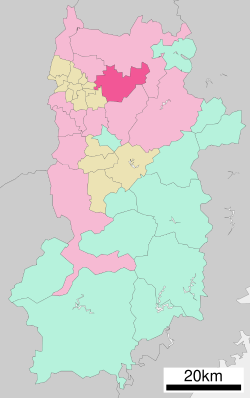Tenri, Nara
You can help expand this article with text translated from the corresponding article in Japanese. (July 2020) Click [show] for important translation instructions.
- Machine translation, like DeepL or Google Translate, is a useful starting point for translations, but translators must revise errors as necessary and confirm that the translation is accurate, rather than simply copy-pasting machine-translated text into the English Wikipedia.
- Consider adding a topic to this template: there are already 3,705 articles in the main category, and specifying
|topic=will aid in categorization. - Do not translate text that appears unreliable or low-quality. If possible, verify the text with references provided in the foreign-language article.
- You must provide copyright attribution in the edit summary accompanying your translation by providing an interlanguage link to the source of your translation. A model attribution edit summary is
Content in this edit is translated from the existing Japanese Wikipedia article at [[:ja:天理市]]; see its history for attribution. - You may also add the template
{{Translated|ja|天理市}}to the talk page. - For more guidance, see Wikipedia:Translation.
City in Kansai, Japan
Tenri  Flag  Seal | |
|---|---|
 Location of Tenri in Nara Prefecture | |
 | |
| Symbols | |
| Flower | Ume |
| Tree | Ginkgo |
Tenri (天理市, Tenri-shi) is a city located in Nara Prefecture, Japan. The modern city was founded on April 1, 1954, and is named after the Japanese new religion Tenrikyo, which has its headquarters in the city. As of April 1, 2015, the city has an estimated population of 66,866, and 29,169 households.[1] The population density is 800.61 persons per km2, and the total area is 86.37 km2.[citation needed]
History
Tenri was briefly the capital of Japan during the reign of Emperor Ninken.[2] The life of the Imperial court was centered at Isonokami Hirotaka Palace where the emperor lived in 488–498.[3]
Education
- Primary schools
- Senzai Elementary School
- Idodo Elementary School
- Yamanobe Elementary School
- Nikaido Elementary School
- Tenri Elementary School (Private School)
- Yanagimoto Elementary School
- Tanbaichi Elementary School
- Ichinomoto Elementary School
- Fukuzumi Elementary School
- Asawa Elementary School
- Junior high schools
- Kita Junior High School
- Minami Junior High School
- Fukuzumi Junior High School
- Nishi Junior High School
- Tenri Junior High School (Private School)
- High schools
- Soekami High School
- Nikaido High School
- Tenri High School (Private School)
- Tenri Kyoko Gakuen High School[4]
- Universities
Shrines and temples

Tenrikyo
Shinto
Transportation
Rail
The central station of Tenri is Tenri Station.
 West Japan Railway Company
West Japan Railway Company - U Sakurai Line (Manyō-Mahoroba Line): Ichinomoto Station – Tenri Station – Nagara Station – Yanagimoto Station
 Kintetsu Railway
Kintetsu Railway
Road
Sister cities
| Tenri | |||||
|---|---|---|---|---|---|
| Japanese name | |||||
| Kanji | 天理市 | ||||
| Hiragana | てんりし | ||||
| |||||
References
- ^ "市町村別推計人口・世帯数". Nara Prefecture. April 1, 2015. Archived from the original on May 18, 2015. Retrieved May 5, 2015.
- ^ Ponsonby-Fane. (1915). The Imperial Family of Japan, p. 15.
- ^ Koch, W. (1904). Japan; Geschichte nach japanischen Quellen und ethnographische Skizzen. Mit einem Stammbaum des Kaisers von Japan, p. 13.
- ^ "Tenri Kyoko Gakuen High School Website".
External links
 Media related to Tenri, Nara at Wikimedia Commons
Media related to Tenri, Nara at Wikimedia Commons Geographic data related to Tenri, Nara at OpenStreetMap
Geographic data related to Tenri, Nara at OpenStreetMap- Tenri City official website (in Japanese)
- v
- t
- e
Nara (capital)
- Nara
























